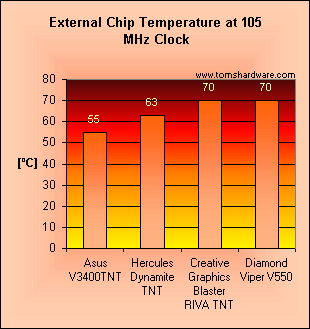Comparison of Graphics Cards with NVIDIA's RIVA TNT Chip
Heat Report Part 1
Everybody who knows about NVIDIA's latest high-end 3D chip is aware of it, the RIVA TNT is getting pretty hot. Thus the card manufacturer should provide some way of cooling, either a passive heat sink, or better a fan/heat sink combination. Testing the chip temperature with your finger may be pretty common, but is miles from accurate. I was using a thermal probe, placed at the PCB opposite the TNT chip. The chip is a BGA model, which ensures pretty good heat dissipation to the PCB over the whole mounting surface of the chip. This is the fairest place to put the probe, because this place is identical for all cards. Fixing it to the heat sink would not have been a smart idea.
The chips get really hot only when running a 3D application, the windows desktop keeps them at about 5-8°C less. I ran my 24-minute 'sewer64' Q2 demo 'tbone.dm2' at 1024x768 and waited until the chip reached its highest temperature. Please realize that the actual chip temperature is higher than what I measured at the other side of the PCB. Another thing to consider is that I tested with a completely open system, letting lots of air to the chip and heat sink. The temperatures measured inside a computer case will be at least another 5°C higher.
The difference in temperature is pretty significant as you can see:
At default clock, only the two cards with active heat sinks can ensure a temperature of less than 60°C. STB's Velocity 4400 is already reaching more than 70°C at default chip clock, which I consider as pretty scary. In a closed case the Velocity can easily reach 80°C or even more.
All cards are still running stable at 100 MHz chip clock, but Elsa's Erazor II and STB's Velocity 4400 are getting damn hot.
At 105 MHz chip clock the Elsa and STB cards crash. This is most likely due to their highly ineffective cooling. The cards from Diamond and Creative are also pretty hot already, but they still run fine.
Get Tom's Hardware's best news and in-depth reviews, straight to your inbox.


